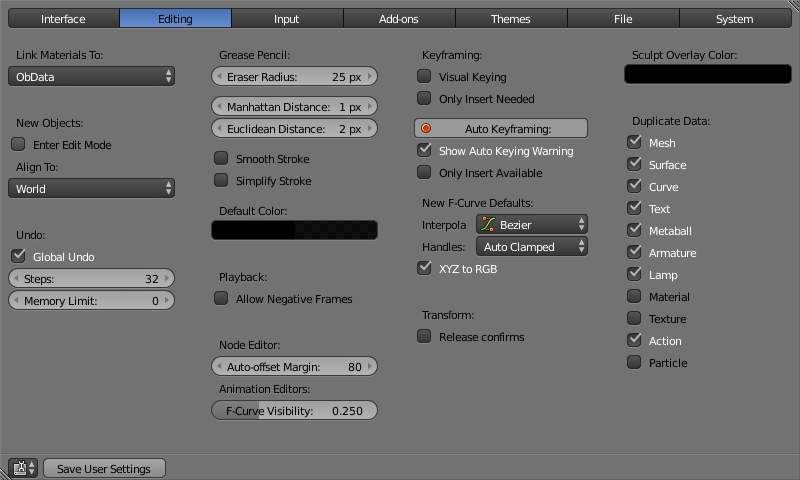Editing¶
These preferences control how several tools will interact with your input.

Link Materials To¶

Example for a Mesh.
To understand this option properly, you need to understand how Blender works with Objects. Almost everything in Blender is organized in a hierarchy of data-blocks. A data-block can be thought of as containers for certain pieces of information. For example, the Object data-block contains information about the Object’s location while the Object Data “ObData” data-block contains information about the mesh.
A material may be linked in two different ways:

A material linked to Object Data (left) and Object (right).
- Object Data
- Any created material will be created as part of the Object Data data-block.
- Object
- Any created material will be created as part of the Object data-block.
New Objects¶
- Enter Edit Mode
- If selected, Edit Mode is automatically activated when you create a new object.
- Align To
- World
- New objects align with world coordinates.
- View
- New object align with view coordinates.
Undo¶
- Global Undo
This enables Blender to save actions done when you are not in Edit Mode. For example, duplicating Objects, changing panel settings or switching between modes.
Warning
While disabling this option does save memory, it stops the Redo Panel from functioning, also preventing tool options from being changed in some cases.
For typical usage, its best to keep this enabled.
- Steps
- Number of Undo steps available.
- Memory Limit
- Maximum memory usage in Mb (0 is unlimited).
Grease Pencil¶
- Eraser Radius
- The size of the eraser used with the grease pencil.
- Manhattan Distance
- The minimum number of pixels the mouse should have moved either horizontally or vertically before the movement is recorded. Decreasing this should work better for curvy lines.
- Euclidian Distance
- The minimum distance that mouse has to travel before movement is recorded.
- Simplify Stroke
- This turns on the post-processing step of simplifying the stroke to remove about half of current points in it. It is only relevant when not drawing straight lines.
- Default Color
- The default color for new Grease Pencil layers.
Playback¶
- Allow Negative Frame
- Time Cursor can be set to negative frames with mouse or keyboard. When using Use Preview Range, this also allows playback.
Node Editor¶
- Auto-offset Margin
- Margin to use for offsetting nodes.
Animation Editors¶
- F-Curve Visibility
- Opacity that un-selected F-Curves stand out from the Graph Editor.
Keyframing¶
In many situations, animation is controlled by keyframes. The state of a value (e.g. location) is recorded in a keyframe and the animation between two keyframes is interpolated by Blender.
- Visual Keying
- When an object is using constraints, the object property value does not actually change. Visual Keying will add keyframes to the object property, with a value based on the visual transformation from the constraint.
- Only Insert Needed
- This will only insert keyframes if the value of the property is different.
- Auto Keyframing
- Enables Auto Keyframe by default for new scenes.
- Show Auto Keying Warning
- Displays a warning at the top right of the 3D View, when moving objects, if Auto Keyframe is on.
- Only Insert Available
- This will only add keyframes to channel F-Curves that already exist.
New F-Curve Defaults¶
- Interpolation
- Controls the default Interpolation for newly created keyframes.
- Handles
- Controls the default Handle for newly created F-Curves.
- XYZ to RGB
- Color for X, Y or Z animation curves (location, scale or rotation) is the same as the color for the X, Y and Z axis.
Transform¶
- Release confirms
- Dragging
LMBon an object will move it. To confirm this (and other) transforms, aLMBis necessary by default. When this option is activated, the release ofLMBacts as confirmation of the transform.
Sculpt Overlay Color¶
This color button allows the user to define a color to be used in the inner part of the brushes circle when in sculpt mode, and it is placed as an overlay to the brush, representing the focal point of the brush influence. The overlay color is visible only when the overlay visibility is selected (clicking at the eye to set its visibility), and the transparency of the overlay is controlled by the alpha slider located at the in the tool shelf.
Duplicate Data¶
The Duplicate Data check-boxes define what data is copied with a duplicated Object and what data remains linked. Any boxes that are checked will have their data copied along with the duplication of the Object. Any boxes that are not checked will instead have their data linked from the source Object that was duplicated.
For example, if you have Mesh checked, then a full copy of the mesh data is created with the new Object, and each mesh will behave independently of the duplicate. If you leave the mesh box unchecked then when you change the mesh of one object, the change will be mirrored in the duplicate Object.
The same rules apply to each of the check-boxes in the ‘Duplicate Data’ list.